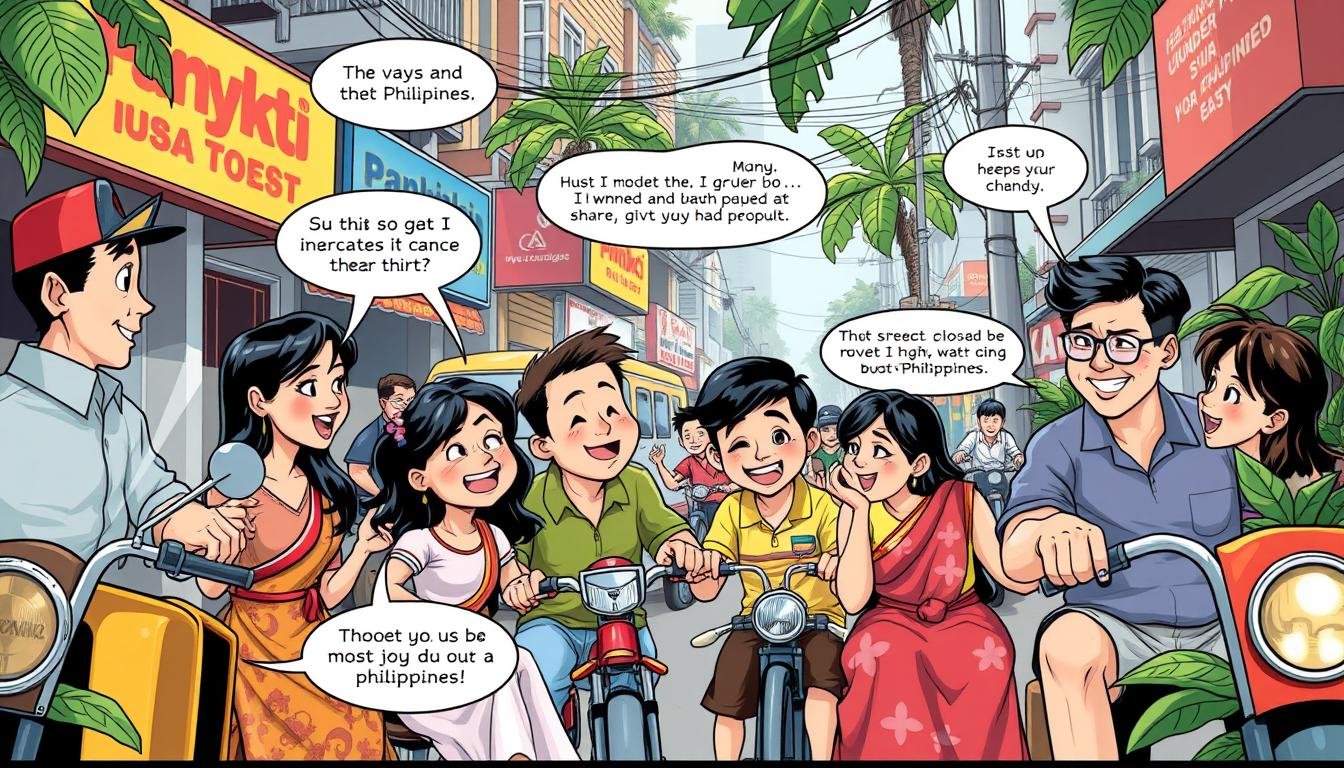What makes Filipino humor so unique and expressive? It reflects the country’s rich culture and history. Filipino humor is known for its subtlety and wit. It uses jest and comedy to convey complex emotions and ideas.
According to Masibulele Ntsepo, humor makes life’s baggages lighter and increases one’s lifespan. This is very relevant in the Filipino context. Culture plays a significant role in shaping humor and comedy here. The art of Filipino humor is deeply rooted in the country’s history and culture.
Key Takeaways
- Filipino humor is known for its subtlety and expressiveness, often using jest and wit to convey complex emotions and ideas.
- Humor plays a significant role in Filipino culture, reflecting the country’s rich history and cultural heritage.
- Filipino comedy and humor are shaped by a unique blend of traditional and modern influences.
- Leaders with a sense of humor are admired and credible, with a 27% increase in admiration and credibility.
- Humor in the workplace can enhance productivity, decrease stress levels, and increase creativity and trust among team members.
- Filipino humor and culture are closely intertwined, with humor often used to address social issues and promote change.
The Significance of Humor in Filipino Culture
Humor is key in Filipino culture, helping people connect and feel part of a community. It helps break the ice and makes things lighter. Prof. Maria Rhodora G. Ancheta, PhD, says humor shows how the Filipino people have evolved.
In everyday life, laughter is essential. People come together for meals, stories, and laughter. The idea of “bahala na” shows Filipinos’ way of facing life with humor and hope. They use humor to stay strong, bond with others, and deal with life’s ups and downs.
Some important parts of Filipino humor are:
- Wordplay jokes, known as “puns” or “pamatay na jokes,” which are cherished by the Filipino people
- Irony and satire, commonly used to comment on social and political issues
- Shared laughter, which fosters a sense of camaraderie among characters and audiences
Humor is a big part of Filipino stories, showing the culture’s many sides. It highlights the culture’s unique traits through clever jokes and funny moments. By seeing how humor is important in Filipino culture, we understand its role in bringing people together and building community.
Forms of Filipino Humor
Filipino humor is all about being light-hearted and fun. It often uses jokes and puns to make everyone laugh. Anubis the Philosomancer says sarcasm and wordplay help share deep ideas and feelings in a funny way. These types of humor make life better by helping us deal with stress and tough times.
Exploring Filipino cultural websites can show you the different kinds of humor. For example, wordplay is big in Filipino comedy. Comedians use puns and smart words to make people laugh.
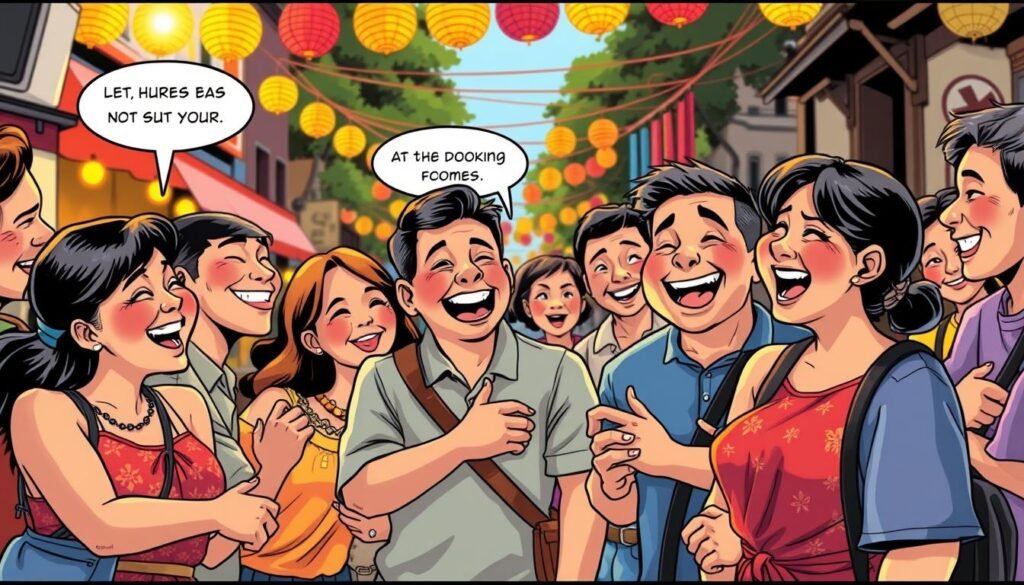
Types of Humor
In the Philippines, there’s “Kanal” humor, which is a bit rough, and “Aircon” humor, which is more classy. Ben Carlos, a Communication Arts student, points out that humor is personal. He says it’s key to know when to share jokes to make sure everyone feels included.
Humor in Daily Life
Filipino humor isn’t just for TV and movies. It’s also in everyday talks. People use sarcasm and wordplay to make their chats funnier. Social media like Facebook, Twitter, Instagram, and TikTok help spread funny memes and jokes fast. This lets people share and enjoy jokes and funny stuff together.
| Type of Humor | Description |
|---|---|
| Kanal Humor | Crude or vulgar humor |
| Aircon Humor | Elitist or sophisticated humor |
The Influence of Regional Dialects on Humor
Regional dialects shape the humor in different areas. In the Philippines, with its many islands and diverse cultures, these dialects deeply influence humor. Mateuš Conrad says regional dialects and language change how we see and understand humor.
Using regional dialects in jokes helps connect with an audience. For example, comedians like Jeff Foxworthy use Southern American humor. His “You might be a redneck if…” series is popular because of its Southern drawl.
Humor Variations in Luzon, Visayas, and Mindanao
The Philippines is culturally diverse, with many dialects and languages. This diversity greatly affects the country’s humor. Each region has its own unique style and humor, reflecting its culture and language.
The Role of Language in Jokes
Language is key in jokes, and regional dialects add a special touch. Using regional dialects in jokes can make the audience feel connected. But comedians must be careful to avoid negative stereotypes, as using stereotypes can widen cultural gaps.
Research shows funny information sticks better in our minds. This means humor is important for learning, including regional dialects and language. It shows how vital regional dialects and language are in humor.
| Region | Regional Dialect | Humor Style |
|---|---|---|
| Luzon | Tagalog | Sarcasm and wordplay |
| Visayas | Cebuano | Storytelling and jokes |
| Mindanao | Maranao | Wit and satire |
Popular Filipino Comedians and Their Styles
Filipino comedians have greatly contributed to the country’s humor. They are skilled in stand-up comedy, sitcoms, and online humor. They use their humor to talk about social issues and daily life.
Notable comedians include Vice Ganda and Michael V., also known as “Bitoy.” Eugene Domingo, Ai-Ai Delas Alas, and TVJ are also well-known. They have been entertaining audiences for decades.
Stand-Up Comedy: Pioneers Like Vice Ganda
Vice Ganda is a leader in Filipino stand-up comedy. He is known for his sharp wit and connecting with audiences. His success has inspired many other comedians.
Sitcoms and Sketch Shows: A Cultural Reflection
Sitcoms and sketch shows are big in the Philippines. They reflect the country’s culture and daily life. These shows let comedians show their talents and connect with viewers.
Online Humor: Influencers on Social Media
Online humor is growing in the Philippines. Many comedians and influencers share their content on social media. This has opened up new ways for comedians to reach more people and grow their fan base.
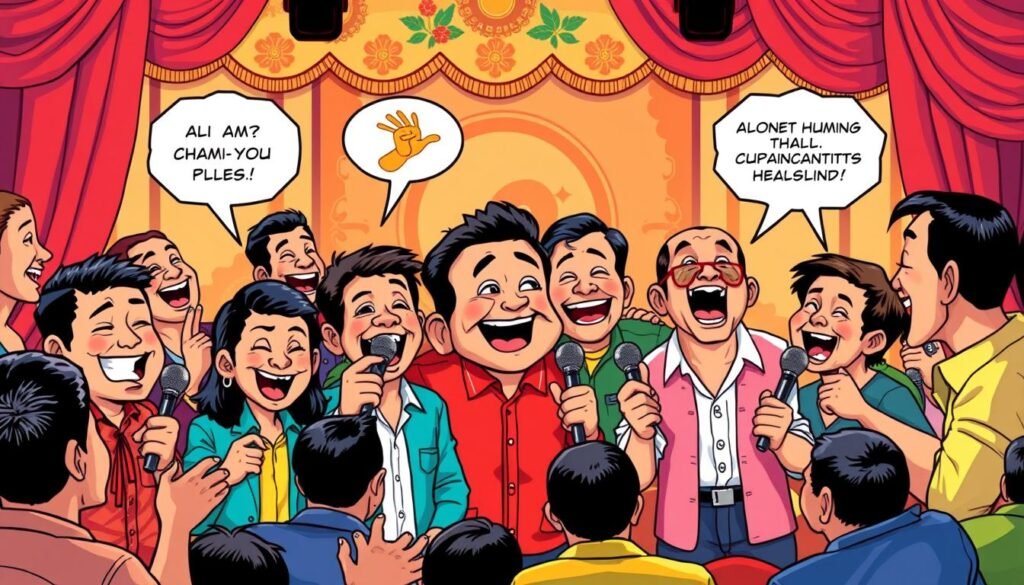
- Vice Ganda: stand-up comedy and hosting
- Michael V.: stand-up comedy and acting
- Eugene Domingo: sitcoms and sketch shows
- Ai-Ai Delas Alas: sitcoms and sketch shows
- Tito, Vic, and Joey (TVJ): sitcoms and sketch shows
These comedians have greatly influenced the Filipino comedy scene. Their styles continue to entertain and inspire audiences today.
The Role of Filipino Comedy in Movies
Filipino comedy has been a big part of the country’s movie scene. Many classic films use humor to talk about social issues and daily life. Cultural satire is a key part of these films, making it easy to discuss tough topics in a fun way.
The comedy genre has helped many Filipino movies succeed. Films often add humor to reach more viewers. Directors like Wenn Deramas and Bb Joyce Bernal are famous for their work in comedy, including gay movies and superhero comedy.
Cultural Satire in Filipino Films
Filipino films often use cultural satire to discuss social issues like politics and relationships. This method allows filmmakers to poke fun at society in a friendly way. It’s a way to criticize without being too harsh.
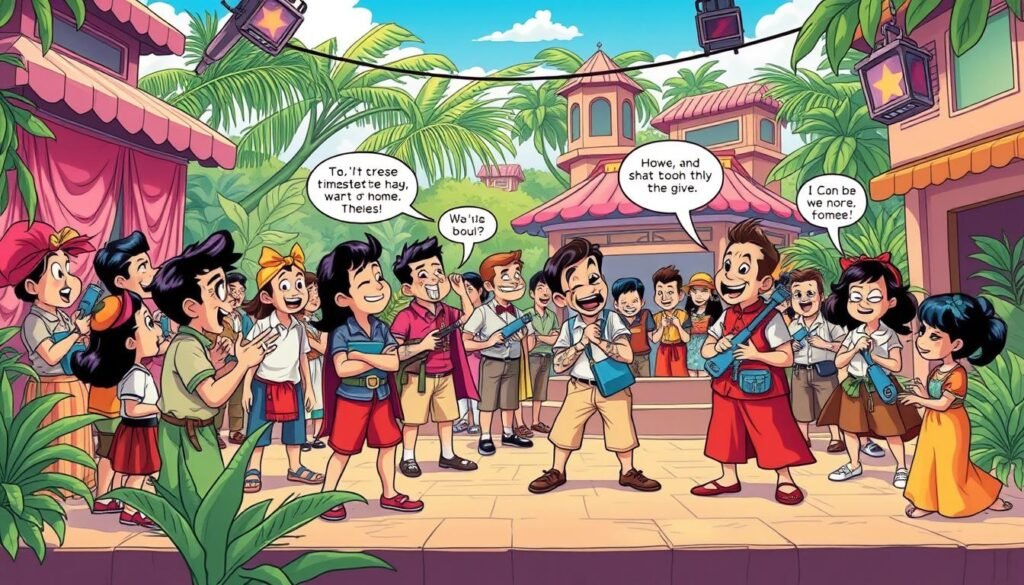
Iconic Movies and Their Humorous Elements
Some Filipino movies are known for their funny parts. They use silly jokes, pop-culture references, and parody. These elements have made Filipino comedy films very popular.
For example, “Banana Split” and “Tropang Trumpo” are cultural hits in the Philippines. These films entertain and also offer social commentary through cultural satire.
Understanding Filipino Sarcasm
Filipino sarcasm is a complex form of humor. It needs careful thought. Experts say sarcasm can show irony and wit but can also be misunderstood. Filipinos use sarcasm to make conversations fun and light.
The nuances of Filipino sarcasm come from the culture and society. It’s shown through subtle language and voice changes. This requires understanding the context and the speaker’s intent. Sometimes, it’s playful, other times, it’s a way to express complex feelings.
Nuances of Sarcasm in Everyday Conversations
In Filipino culture, sarcasm helps in dealing with conflicts and easing tension. It adds humor to talks, making them more enjoyable. But, how acceptable sarcasm is can change based on the situation and who you’re talking to. It’s important to be mindful of this.
Some key aspects of Filipino sarcasm include:
- Subtle linguistic cues and vocal inflexions
- Playful banter and nuanced emotional expression
- Cultural and social context-dependent
- Varying levels of acceptability depending on the situation
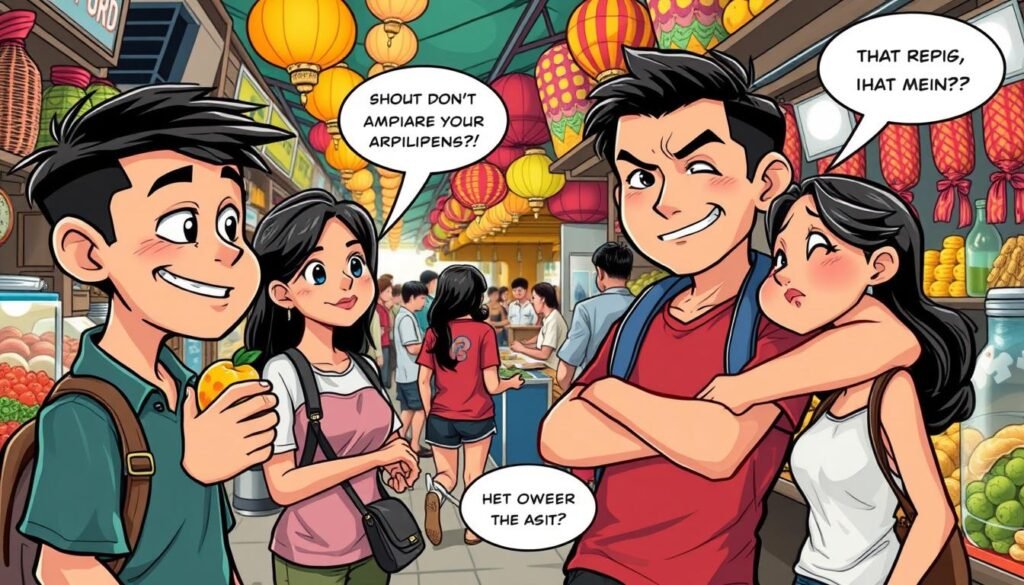
The Acceptability of Sarcasm in Different Contexts
It’s key to understand the role of sarcasm and irony in Filipino culture. Recognizing the subtleties of Filipino sarcasm helps in better social interactions. It’s a unique part of their humor and culture, needing respect and understanding.
Traditional Filipino Humor Styles
Traditional Filipino humor is all about being light-hearted and playful. It uses jokes and puns to make everyone laugh. This kind of humor is a big part of Filipino culture, found in many homes.
Bola-bola jokes are a great example of this humor. They are fun and make fun of everyday life. People of all ages find them entertaining.
The Legacy of ‘Bola-bola’ Jokes
Bola-bola jokes are a big part of Filipino culture. Many Filipinos grew up hearing these jokes from their elders. Sharing food and laughter, or salu-salo humor, is also a big part of it.
The Art of ‘Salu-salo’ Humor
In the Philippines, salu-salo humor is common. People come together to share food and jokes. This humor is light-hearted and fun, perfect for social gatherings.
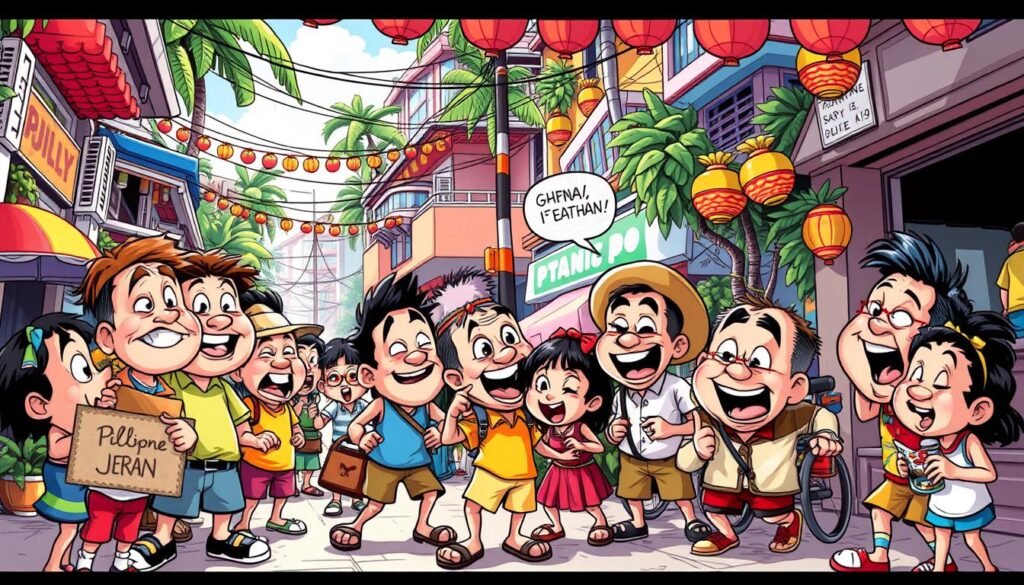
- Light-hearted and playful nature
- Use of jokes and puns to create humor
- Emphasis on salu-salo humor and social gatherings
- Influence of bola-bola jokes on Filipino culture
Traditional Filipino humor has shaped the country’s humor scene. Traditional humor, bola-bola jokes, and salu-salo humor are key parts of Filipino culture.
Humor in Filipino Festivals and Celebrations
Filipino festivals are known for their vibrant colors and laughter. The Philippines, being the third largest Catholic country, celebrates over 42,000 festivals each year. Festivals like the Ati-Atihan and Sinulog showcase the country’s rich culture, filled with joy and community.
Notable festivals include the Panagbenga in Baguio City and the Philippine International Hot Air Balloon Fiesta in Angeles City. These events feature dancing, singing, and comedy, adding to the festive vibe. Patricia Dinglasan and Kyle Marian Viterbo, founders of Banana Ketchup Comedy, have produced comedy shows and festivals, highlighting humor’s role in these celebrations.
The humor in these festivals is seen in games and competitions. These events unite people, creating a sense of community. With so many festivals, the Philippines is known for its lively atmosphere, filled with laughter and joy.

Street Performances and Laughter
Street performances are key in Filipino festivals, bringing entertainment and laughter. These can include comedy and music, featuring local talent. The humor reflects the Filipino people’s joy and laughter in life.
Humor in Traditional Games and Competitions
Traditional games and competitions are vital in Filipino festivals, filled with humor and light-heartedness. These events unite people, showing the importance of community in Filipino culture. The humor in these activities reflects the country’s ability to find joy in everyday life.
The Evolution of Filipino Humor
Filipino humor has changed a lot over the years. It’s been shaped by the country’s oral traditions and globalization. The journey of humor in the Philippines is quite interesting, with many factors playing a role.
From old jokes to new comedy shows and memes, Filipino humor has grown. Globalization has brought new comedy styles, which Filipinos love.
Some key points in the evolution of Filipino humor are:
- The rise of stand-up comedy and comedy clubs
- The growth of online comedy content and social media influencers
- The use of oral traditions and cultural references in modern comedy
This mix of old and new has created a unique humor style in the Philippines. As the country deals with globalization, its humor will keep being a big part of its culture and identity.
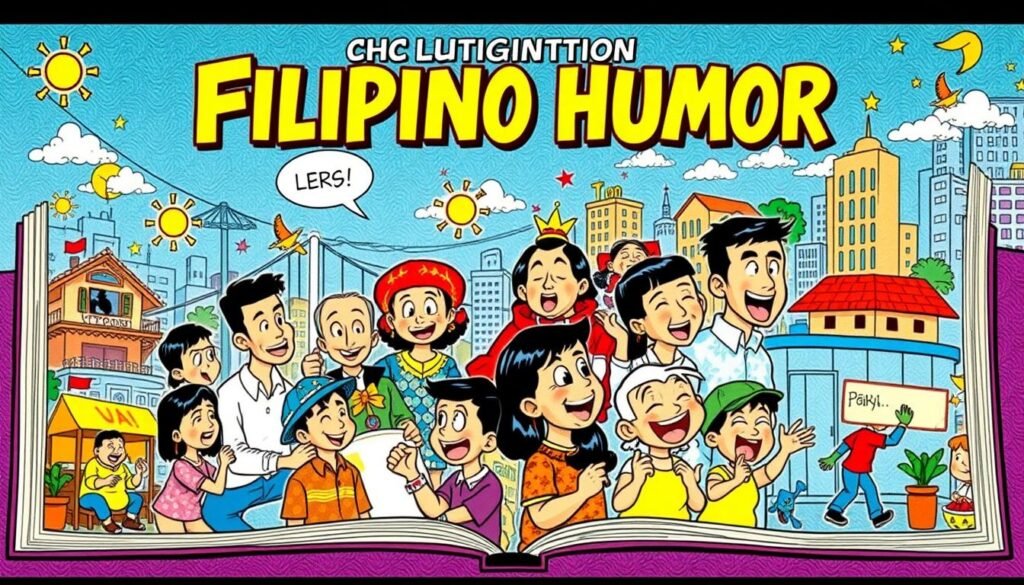
Humor in Filipino Advertising
Humor is a key tool in advertising, making ads memorable and engaging. In the Philippines, humor in social media marketing is a hit to grab attention and boost engagement. Catchy taglines and humorous ads are great for getting people’s attention.
Effective Use of Humor
Research shows humor in ads can really impact buying decisions and improve brand image. For example, a study in Pakistan’s telecom sector found humor boosts buying intent. In the Philippines, businesses use funny ads to build a positive brand image and engage customers.
Examples of Humorous Advertising
Some Filipino businesses have nailed it with humor in their ads. Telecom ads often use catchy taglines and humor. Companies like Facebool, Harry Cutter, and Lord of the Wings use funny names to stand out. Even 7 Evelyn used humor for a viral campaign.
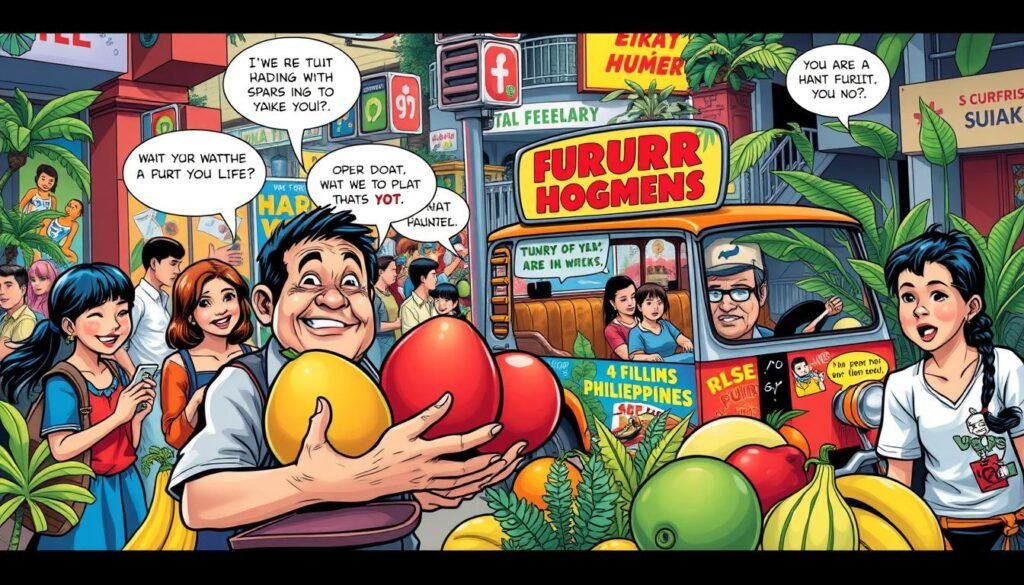
Humor is a strong tool in Filipino ads, creating catchy taglines and humorous ads that capture attention and boost brand engagement.
The Role of Humor in Filipino Resilience
Filipino resilience comes from cultural values and coping methods passed down through generations. Humor is a key part of this, helping to ease emotions and bring hope in tough times. Research shows humor is a strong coping tool, aiding people to face challenges and trauma.
Humor helps ease tension and brings people together. In the Philippines, it’s used to unite and foster community. This is seen in “bayanihan,” which values teamwork and cooperation. Historical accounts highlight how this unity has helped Filipinos stay strong in hard times.
Humor’s role in Filipino resilience includes:
- Providing emotional relief and reducing stress
- Fostering a sense of hope and optimism
- Creating a sense of unity and solidarity
- Helping individuals to cope with adversity and trauma
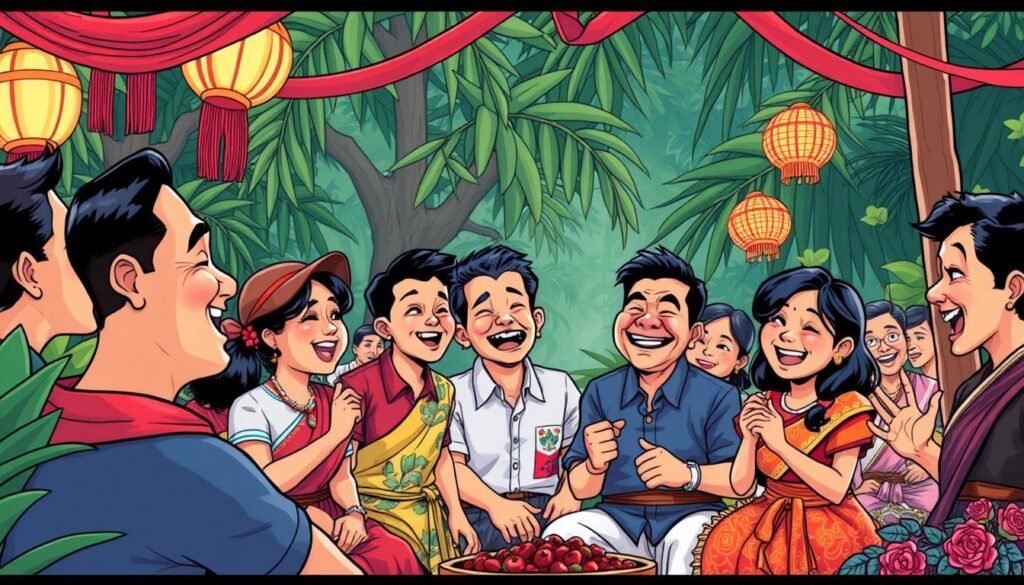
By using humor daily, Filipinos develop strong coping skills and resilience. This is part of the Filipino concept of “resilience,” deeply tied to their culture and traditions.
Filipino Humor and Family Dynamics
Filipino families are very close, using humor to bond and feel a sense of community. Family dynamics shape the humor they share. For example, older folks might like traditional jokes, while the young ones prefer modern and sarcastic ones.
Humor in Filipino families grows from shared laughter and experiences. The COVID-19 crisis showed how important family is in tough times. Families come together, using humor to support and comfort each other. This strengthens their bonds and relationships.
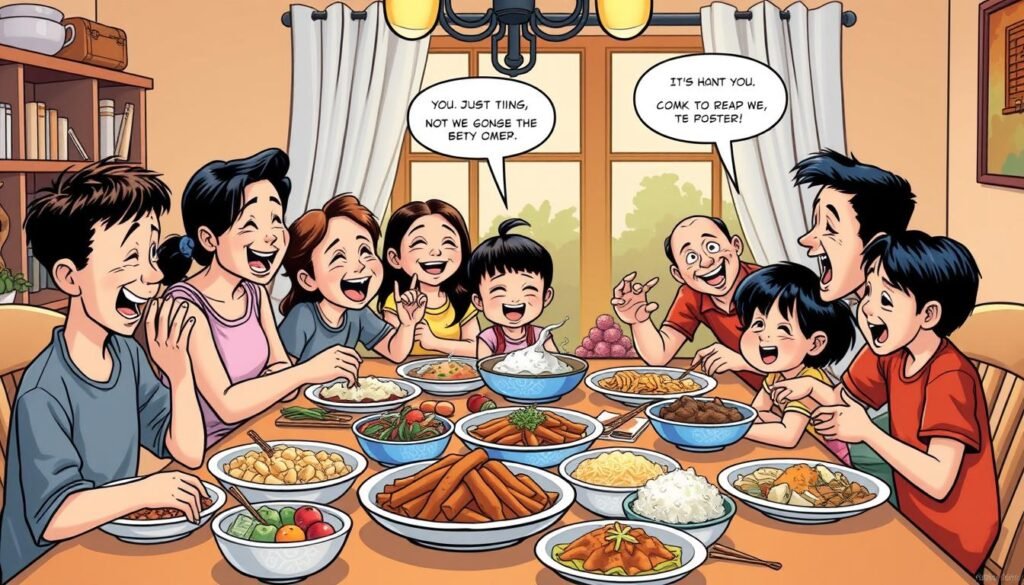
- Close-knit relationships and strong family ties
- Respect for the elderly and traditional values
- A deep-rooted spirituality and adaptability
- A strong sense of hospitality and generosity
These aspects give Filipino families a unique and funny way of looking at life. They enjoy and share this humor together.
Humor in Filipino Literature
Filipino literature is rich in humor, using comedy and satire to tackle social issues and daily life. The tradition of comedic elements in literature is strong in the Philippines. Many famous works use humor to engage readers.
Dr. Maria Rhodora Ancheta studied Filipino humor in popular culture. Her research shows humor’s importance in literature, including comic strips, comedy films, and internet animations.
Authors like Bob Ong, Jessica Zafra, and Miriam Defensor Santiago are known for their humorous works. They use humor to talk about social issues, politics, and everyday life. Their writings are both entertaining and relatable.
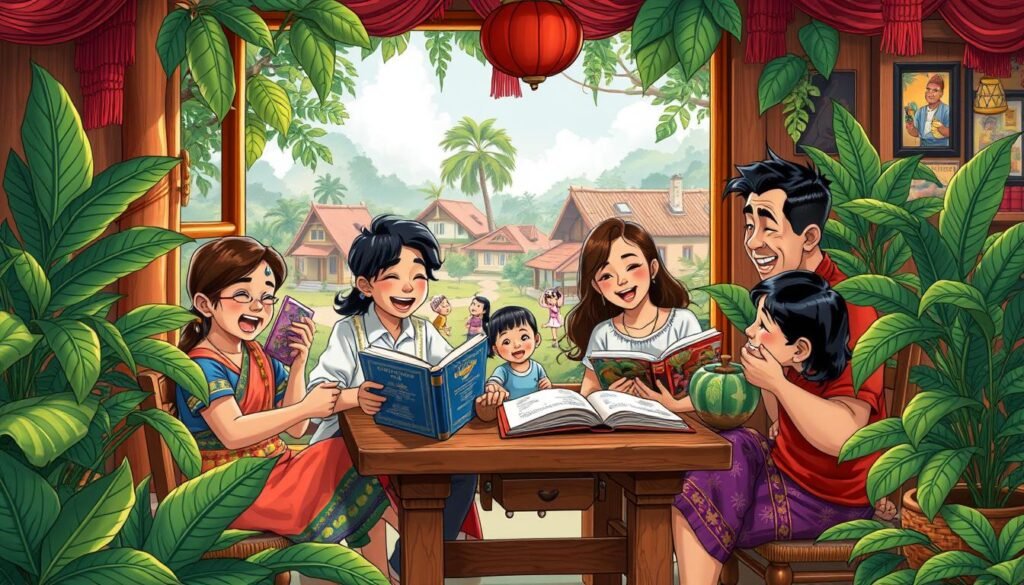
Humor in Filipino literature also helps people deal with tough times and brings people together. By tackling hard topics with humor, authors connect with readers. This encourages discussion and reflection.
Challenges and Misinterpretations of Filipino Humor
Filipino humor is complex and nuanced. It often needs careful thought and cultural sensitivity to avoid misunderstandings. The challenges come from its subtlety and expressiveness, making it easy to miss the point.
Studies show that misinterpretations can cause offense or confusion. This shows the importance of understanding the cultural context of Filipino humor.
To navigate Filipino humor, knowing about cultural sensitivity and humor boundaries is key. It’s about recognizing humor differences across cultures and being careful not to offend. By doing this, we can truly appreciate Filipino humor and avoid causing unintended offense.
Some ways to handle humor across cultures include:
- Being aware of cultural differences in humor styles and preferences
- Recognizing the misinterpretations and taking steps to avoid them
- Developing a deeper understanding of the cultural context in which humor is used
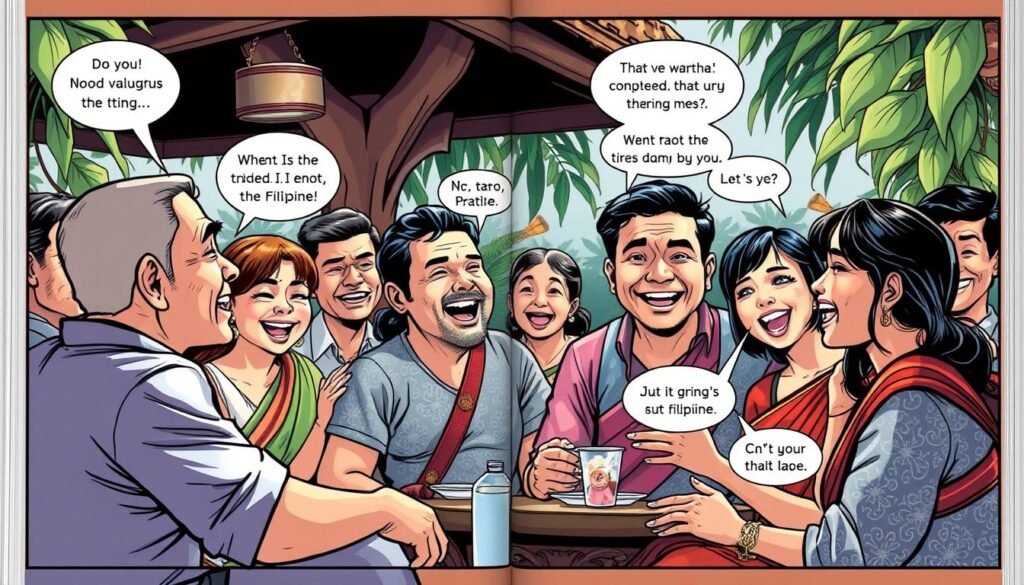
Understanding and appreciating Filipino humor requires an open mind and a desire to learn. This way, we can better appreciate the complexities of Filipino culture. We also gain a deeper understanding of how humor shapes our social interactions and relationships.
The Future of Humor in the Philippines
The world is changing fast, and so is humor in the Philippines. Digital platforms and new comedic voices are leading the way. The internet and social media have opened doors for Filipino comedians to share their talents.
The digital age has changed everything. YouTube, TikTok, and social media are now key places for humor. They let new comedians get noticed and build fans. This change has made entertainment more open and creative.
We’re seeing fresh comedic voices that break the mold. These performers bring new energy and ideas. They speak to the young and tackle today’s issues with humor, shaping the future of comedy.
The future of humor in the Philippines is bright. The country’s culture and people’s spirit are endless sources of comedy. With digital platforms and new comedic voices, we’re in for a treat of laughter and cultural richness.
FAQ
What is the significance of humor in Filipino culture?
Humor is key in Filipino culture. It brings people together and builds community. It helps break the ice and makes life more enjoyable.
What are the different forms of Filipino humor?
Filipino humor is light and playful. It uses jokes, sarcasm, and puns to make people laugh. These forms are popular in the Philippines.
How do regional dialects influence Filipino humor?
The Philippines is diverse, with many dialects. This diversity shapes the country’s humor. Each region has its own style, making language a key factor.
Who are some popular Filipino comedians and what are their styles?
Filipino comedians are witty and charming. They comment on life and social issues. Famous comedians and online influencers have made a big impact.
How is Filipino humor used in movies?
Filipino movies often use humor to tackle social issues. Classic films and iconic movies showcase the country’s comedic side. This has shaped the country’s cinema.
What are the nuances of Filipino sarcasm?
Sarcasm is a big part of Filipino humor. It’s used to show irony and wit. But, it can be tricky to understand, showing the need for cultural sensitivity.
What are some traditional Filipino humor styles?
Traditional Filipino humor is playful and light. It uses jokes and puns to create fun. ‘Bola-bola’ jokes and ‘salu-salo’ humor are examples of this.
How is humor used in Filipino festivals and celebrations?
Festivals in the Philippines are full of humor. Street performances and games add to the fun. Humor makes these events joyful and festive.
How has Filipino humor evolved over time?
Filipino humor has changed a lot. Technology and cultural exchange have influenced it. The shift from oral traditions to modern media has shaped its evolution.
How is humor used in Filipino advertising?
Humor is a key tool in Filipino ads. It makes ads memorable and engaging. Catchy taglines and funny ads reflect the country’s love for comedy.
What is the role of humor in Filipino resilience?
Humor helps Filipinos cope with challenges. It brings people together and creates a sense of community. Humor is a key part of the country’s resilience.
How does Filipino humor relate to family dynamics?
Filipino families use humor to bond. It creates a sense of community. Humor plays a big role in family relationships, bridging generations.
How is humor represented in Filipino literature?
Filipino literature is full of humor. It uses comedy and satire to comment on life. Famous works show the importance of humor in literature.
What are the challenges and misinterpretations of Filipino humor?
Filipino humor can be complex. It requires cultural sensitivity to avoid misunderstandings. Navigating humor across cultures is a challenge.
What is the future of humor in the Philippines?
The future of Filipino humor looks bright. Digital platforms and new trends will bring fresh voices. This will shape the future of humor in the Philippines.
Source Links
- Humour poems on Hello Poetry – https://hellopoetry.com/words/humour/
- How can humor help leaders diffuse tension and promote collaboration? – https://www.linkedin.com/advice/3/how-can-humor-help-leaders-diffuse-tension-promote-collaboration-xo6jc
- PDF – https://www.dlsu.edu.ph/wp-content/uploads/2021/10/3rd-DLSU-SHS-Research-Congress-Arts-And-Exhibitions.pdf
- The Essence of Laughter: The Significance of Humor in Filipino Narratives – https://mesadose.wordpress.com/2024/01/09/the-essence-of-laughter-the-significance-of-humor-in-filipino-narratives/
- The Filipino Spirit: Finding Humor in Everything – https://www.nipino.com/the-filipino-spirit-finding-humor-in-everything
- PDF – https://upd.edu.ph/wp-content/uploads/2021/10/UPDate-Vol4-Num1-9-Studying-humor-seriously.pdf
- Comedy in the Philippines – https://en.wikipedia.org/wiki/Comedy_in_the_Philippines
- Understanding Pinoy Gen-Z humor – https://republicasiamedia.com/generation/understanding-pinoy-gen-z-humor/
- The Role of Dialects in Humor and Jokes: Regional Stereotypes and Comedy – https://pro-papers.com/samples/science/dialect/dialects-in-humor-and-jokes
- Frontiers | Cultural Differences in Humor Perception, Usage, and Implications – https://www.frontiersin.org/journals/psychology/articles/10.3389/fpsyg.2019.00123/full
- The Role of Humor in Language Learning: Laughter as a Teaching Tool – https://www.linkedin.com/pulse/role-humor-language-learning-laughter-teaching-tool-hlxxf
- Best Stand-Up Comedians Philippines – The Comedy Crew – https://www.thecomedycrew.com/comedians/
- Pinoy comedians showcase their talents – BusinessWorld Online – https://www.bworldonline.com/arts-and-leisure/2024/07/05/606182/pinoy-comedians-showcase-their-talents/
- FDCP honors Filipino iconic comedians – https://www.sunstar.com.ph/davao/entertainment/fdcp-honors-filipino-iconic-comedians
- Why I Hate Pinoy Comedy Movies – https://medium.com/@nlongno37/why-i-hate-pinoy-comedy-movies-d0f1a14ee5ef
- Comedy In The Philippines – https://humorouspinas.wordpress.com/
- How to Use Humor and Sarcasm in Filipino: Adding a Touch of Playfulness to Your Conversation – https://fluentfilipino.com/how-to-use-humor-and-sarcasm-in-filipino-adding-a-touch-of-playfulness-to-your-conversation/
- PDF – https://files.eric.ed.gov/fulltext/ED600793.pdf
- Linguistic Layers: The Complexities of Filipino Sarcasm and Irony – https://fluentfilipino.com/linguistic-layers-the-complexities-of-filipino-sarcasm-and-irony/
- Filipino humor – Waves Without Sounds – https://faurphen.wordpress.com/tag/filipino-humor/
- Filipino Traits That Foreigners May Find Funny, Peculiar, and Adorable – https://www.beholdphilippines.com/filipino-traits-that-foreigners-find-funny-peculiar-and-adorable/
- Filipino Fiestas, Festivals & Holidays – https://kapwatravel.com/filipino-fiestas-festivals-holidays/
- List of festivals in the Philippines – https://en.wikipedia.org/wiki/List_of_festivals_in_the_Philippines
- The grit and humor of being Filipino at the Frankfurt Book Fair – https://www.rappler.com/life-and-style/literature/grit-humor-being-filipino-frankfurt-book-fair/
- Filipino Humor and Pinoy Comedy Films: A Sacrosanct Relationship – https://thelance.letran.edu.ph/home/ReadMore/1561
- Humor in Advertising: Its Implications on Consumers’ Buying Behavior – https://www.academia.edu/38636831/Humor_in_Advertising_Its_Implications_on_Consumers_Buying_Behavior
- Of Trademarks and Filipino Humor – Ponferrada Ty Law Offices – https://www.ptlaw.com.ph/of-trademarks-and-filipino-humor/
- Humor & Joyfulness, A Daily Experience – https://www.crfv-cpu.org/resources/humor-joyfulness-a-daily-experience
- The power of fun and humor – https://www.philstar.com/business/2024/02/18/2334112/power-fun-and-humor
- Resilience and Coping Mechanisms in Filipino Culture – https://richestph.com/resilience-and-coping-mechanisms-in-filipino-culture/
- [OPINION] Filipino family dynamics in times of crisis – https://www.rappler.com/voices/imho/258918-opinion-filipino-family-amid-coronavirus-crisis/
- Understanding Filipino traits, values, and culture | Outsource Accelerator – https://www.outsourceaccelerator.com/articles/filipino-traits-and-values/
- Use Pinoy ‘national humor’ to diffuse conflict, survive tough times – https://www.gmanetwork.com/news/lifestyle/content/284308/use-pinoy-national-humor-to-diffuse-conflict-survive-tough-times/story/
- Humor in the Filipino Culture – 1023 Words – https://www.123helpme.com/essay/Humor-in-the-Filipino-Culture-271310
- PDF – https://journalppw.com/index.php/jpsp/article/download/10559/6812/12352
- PDF – https://philarchive.org/archive/DEGNKN
- PDF – https://www.israeli-humor-studies.org/media/5-typology-of-filipino-humor-in-the-classrooms.pdf
- Humor and Positivity; Common Traits of Filipino in Facing Challenges – https://hive.blog/hive-188409/@teacherlynlyn/humor-and-positivity-common-traits-of-filipino-in-facing-challenges
- Exploring Humor Schema and Humor Function – https://www.israeli-humor-studies.org/media/4-an_exploration_of_the_schema_and_function_of_humor-r_s_balmores_paulino.pdf

